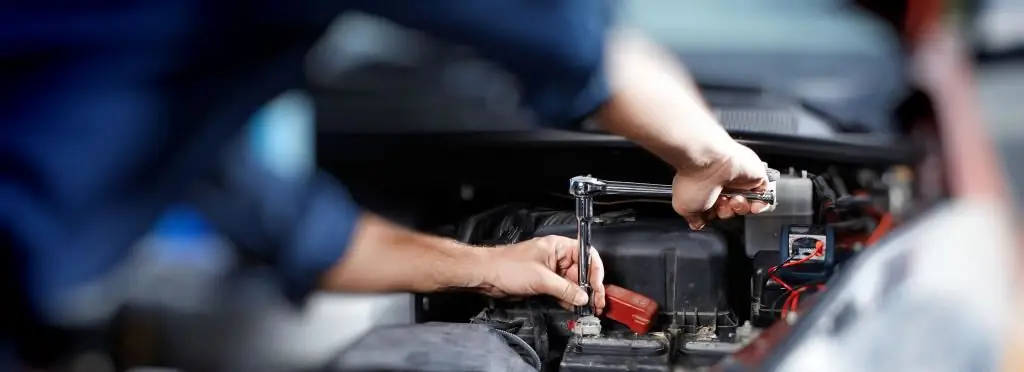2025 Author: Erin Ralphs | [email protected]. Last modified: 2025-01-22 21:14:16
With the advent of internal combustion engines and the improvement of their designs, the need for centralized and controlled fuel injection into the combustion chambers has become acute. Various manufacturers of automotive equipment have come to almost the same design in terms of meaning, which allows fuel to be supplied to the combustion chamber. A special device called a fuel rail was developed. With the help of this device, automotive equipment received a stable supply of fuel to the cylinder.
Fuel rail
The fuel rail is an essential element of the fuel system of automotive vehicles, without which the normal operation of an internal combustion engine with distributed injection is impossible. The fuel rail is a hollow tube closed at both ends. Holes with taps run along the entire length of the tube, to which tubes with nozzles at the ends are attached. The rail migrated to the gasoline engine from the diesel unit.

Sometimes the injectors themselves are structurally attached directly to the rail, which slightly simplifies the design of the fuel system. Initially, the rack was used only in engines based on diesel fuel; in the era of carbureted gasoline engines, it was not used. And only with the advent of internal combustion engines on gasoline fuel and an injector, the fuel rail has found wide application.
Description of work
During engine start, the charge pump delivers gasoline to the fuel line. Fuel tends to the far wall of the tube, getting into the fuel rail. At the same time, the necessary pressure is reached in the system for normal operation of the engine. Sometimes the fuel supply system is equipped with heating from the heat of a running engine. Heated fuel improves its performance and increases atomization when it enters the combustion chamber.

When servicing the fuel rail, follow the rules of technical operation in order to avoid its failure. When dismantling, care must be taken not to damage the connectors and nozzle nozzles. Do not allow dirt to enter open channels and holes, this will disrupt the normal operation of the fuel system, therefore, when working with a fuel rail, close the holes with plugs. Before dismantling, the rail is cleaned with a special cleaning bottle.
It is forbidden to place the rail insolvents - this will lead to failure of the rubber gaskets between the nozzles and the rail, so the instructions recommend that you change the gaskets when disassembling, even if they are visually in good condition.
Design feature
In automotive technology on the engine, the rail is installed on the intake manifold. Keep in mind that in addition to the outlets to the injectors, the rail has a hole on which a fitting is installed for attaching a pressure gauge - it helps to control the pressure in the fuel rail. To prevent debris from getting inside (provided there is no pressure gauge), the hole is blocked with a threaded plug. The nozzle has a fuel rail valve that prevents fuel from escaping unnecessarily.

The material of the tube is steel, which does not have seams, which allows it to withstand high pressure in the fuel system.
Application
As described above, the fuel rail is designed for timely and normal fuel injection into the combustion chamber. Fuel is supplied at a certain temperature and under the required pressure. All this can be adjusted and controlled using special devices located on the rail and in it - they will ensure the correct and stable operation of the internal combustion engine.
Recommended:
Metallic (car paint): features, applications and reviews

Many car owners, when buying another car, read in the ad or in the specification for the car that the body is painted with metallic paint. Sellers and manufacturers indicate that the latter has a lot of advantages. So, cars treated in this way are more expensive than cars in ordinary paint. Why is this happening? Let's find out what metallic (paint) is, why every car owner dreams of it and why you need to pay extra for it
How to choose a fuel saver? Comparison of Fuel Shark and Neosocket

Many car owners have heard about such a device as a fuel saver, but not many people know its advantages and principle of operation, as well as its main characteristics. We will study in the article whether devices can really save fuel consumption, by how much, and also compare the popular Fuel Shark and Neosocket models
Fuel tank capacity. The device and dimensions of the fuel tank of the car

Each car has its own fuel tank capacity. There is no specific standard for the volume parameter that all car manufacturers would adhere to. Let's figure out what are the capacities of different types of fuel tanks, determine the features and structure of these elements
Car operation is Types, characteristics, categories, depreciation and fuel consumption calculations, features of work and technical use

Logistics of road transport is an important factor in technical operation systems and is a process of supplying automobile enterprises with rolling stock, units, spare parts, tires, batteries and materials necessary for their normal operation. Proper organization of logistics plays a crucial role in improving the use of vehicles by keeping them in good condition
Vorovaika car: varieties, applications and prices

Legal and illegal use of "vorovaiki". Varieties of self-loaders and the services they provide. Approximate cost of renting and buying a crane

